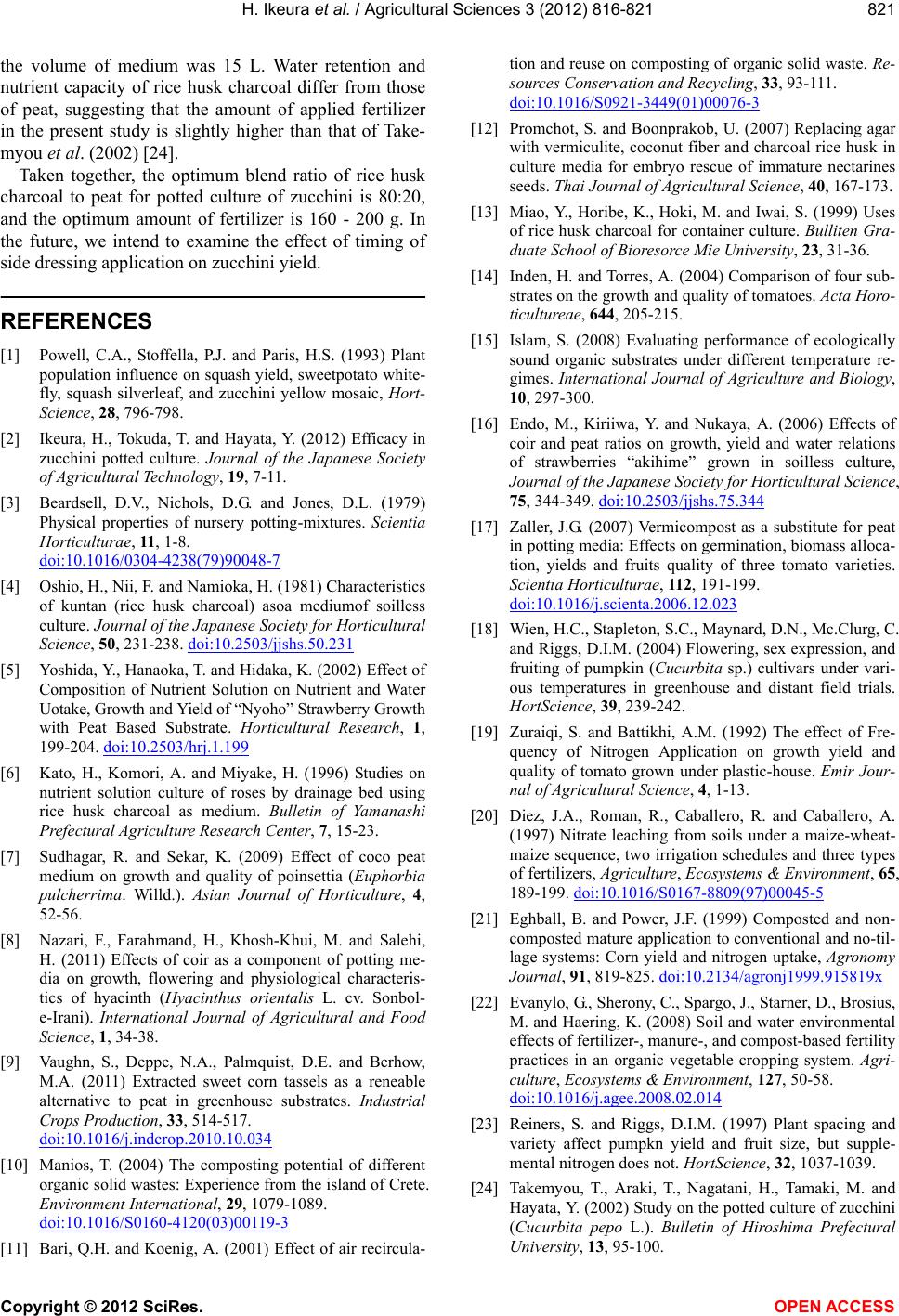
H. Ikeura et al. / Agricultural Sciences 3 (2012) 816-821 821
the volume of medium was 15 L. Water retention and
nutrient capacity of rice husk charcoal differ from those
of peat, suggesting that the amount of applied fertilizer
in the present study is slightly higher than that of Take-
myou et al. (2002) [24].
Taken together, the optimum blend ratio of rice husk
charcoal to peat for potted culture of zucchini is 80:20,
and the optimum amount of fertilizer is 160 - 200 g. In
the future, we intend to examine the effect of timing of
side dressing application on zucchini yield.
REFERENCES
[1] Powell, C.A., Stoffella, P.J. and Paris, H.S. (1993) Plant
population influence on squash yield, sweetpotato white-
fly, squash silverleaf, and zucchini yellow mosaic, Hort-
Science, 28, 796-798.
[2] Ikeura, H., Tokuda, T. and Hayata, Y. (2012) Efficacy in
zucchini potted culture. Journal of the Japanese Society
of Agricu ltural Technolo gy, 19, 7-11.
[3] Beardsell, D.V., Nichols, D.G. and Jones, D.L. (1979)
Physical properties of nursery potting-mixtures. Scientia
Horticulturae, 11, 1-8.
doi:10.1016/0304-4238(79)90048-7
[4] Oshio, H., Nii, F. and Namioka, H. (1981) Characteristics
of kuntan (rice husk charcoal) asoa mediumof soilless
culture. Journal of the Japanese Society for Horticultural
Science, 50, 231-238. doi:10.2503/jjshs.50.231
[5] Yoshida, Y., Hanaoka, T. and Hidaka, K. (2002) Effect of
Composition of Nutrient Solution on Nutrient and Water
Uotake, Growth and Yield of “Nyoho” Strawberry Growth
with Peat Based Substrate. Horticultural Research, 1,
199-204. doi:10.2503/hrj.1.199
[6] Kato, H., Komori, A. and Miyake, H. (1996) Studies on
nutrient solution culture of roses by drainage bed using
rice husk charcoal as medium. Bulletin of Yamanashi
Prefectural Agriculture Resear ch Center, 7, 15-23.
[7] Sudhagar, R. and Sekar, K. (2009) Effect of coco peat
medium on growth and quality of poinsettia (Euphorbia
pulcherrima. Willd.). Asian Journal of Horticulture, 4,
52-56.
[8] Nazari, F., Farahmand, H., Khosh-Khui, M. and Salehi,
H. (2011) Effects of coir as a component of potting me-
dia on growth, flowering and physiological characteris-
tics of hyacinth (Hyacinthus orientalis L. cv. Sonbol-
e-Irani). International Journal of Agricultural and Food
Science, 1, 34-38.
[9] Vaughn, S., Deppe, N.A., Palmquist, D.E. and Berhow,
M.A. (2011) Extracted sweet corn tassels as a reneable
alternative to peat in greenhouse substrates. Industrial
Crops Production, 33, 514-517.
doi:10.1016/j.indcrop.2010.10.034
[10] Manios, T. (2004) The composting potential of different
organic solid wastes: Experience from the island of Crete.
Environment International, 29, 1079-1089.
doi:10.1016/S0160-4120(03)00119-3
[11] Bari, Q.H. and Koenig, A. (2001) Effect of air recircula-
tion and reuse on composting of organic solid waste. Re-
sources Conservation and Recycling, 33, 93-111.
doi:10.1016/S0921-3449(01)00076-3
[12] Promchot, S. and Boonprakob, U. (2007) Replacing agar
with vermiculite, coconut fiber and charcoal rice husk in
culture media for embryo rescue of immature nectarines
seeds. Thai Journal of Agricultural Science, 40, 167-173.
[13] Miao, Y., Horibe, K., Hoki, M. and Iwai, S. (1999) Uses
of rice husk charcoal for container culture. Bulliten Gra-
duate School of Bioresorce Mie University, 23, 31-36.
[14] Inden, H. and Torres, A. (2004) Comparison of four sub-
strates on the growth and quality of tomatoes. Acta Horo-
ticultureae, 644, 205-215.
[15] Islam, S. (2008) Evaluating performance of ecologically
sound organic substrates under different temperature re-
gimes. International Journal of Agriculture and Biology,
10, 297-300.
[16] Endo, M., Kiriiwa, Y. and Nukaya, A. (2006) Effects of
coir and peat ratios on growth, yield and water relations
of strawberries “akihime” grown in soilless culture,
Journal of the Japanese Society for Horticultural Science,
75, 344-349. doi:10.2503/jjshs.75.344
[17] Zaller, J.G. (2007) Vermicompost as a substitute for peat
in potting media: Effects on germination, biomass alloca-
tion, yields and fruits quality of three tomato varieties.
Scientia Horticulturae, 112, 191-199.
doi:10.1016/j.scienta.2006.12.023
[18] Wien, H.C., Stapleton, S.C., Maynard, D.N., Mc.Clurg, C.
and Riggs, D.I.M. (2004) Flowering, sex expression, and
fruiting of pumpkin (Cucurbita sp.) cultivars under vari-
ous temperatures in greenhouse and distant field trials.
HortScience, 39, 239-242.
[19] Zuraiqi, S. and Battikhi, A.M. (1992) The effect of Fre-
quency of Nitrogen Application on growth yield and
quality of tomato grown under plastic-house. Emir Jour-
nal of Agricultural Science, 4, 1-13.
[20] Diez, J.A., Roman, R., Caballero, R. and Caballero, A.
(1997) Nitrate leaching from soils under a maize-wheat-
maize sequence, two irrigation schedules and three types
of fertilizers, Agriculture, Ecosystems & Environment, 65,
189-199. doi:10.1016/S0167-8809(97)00045-5
[21] Eghball, B. and Power, J.F. (1999) Composted and non-
composted mature application to conventional and no-til-
lage systems: Corn yield and nitrogen uptake, Agronomy
Journal, 91, 819-825. doi:10.2134/agronj1999.915819x
[22] Evanylo, G., Sherony, C., Spargo, J., Starner, D., Brosius,
M. and Haering, K. (2008) Soil and water environmental
effects of fertilizer-, manure-, and compost-based fertility
practices in an organic vegetable cropping system. Agri-
culture, Ecosystems & Environment, 127, 50-58.
doi:10.1016/j.agee.2008.02.014
[23] Reiners, S. and Riggs, D.I.M. (1997) Plant spacing and
variety affect pumpkn yield and fruit size, but supple-
mental nitrogen does not. HortScience, 32, 1037-1039.
[24] Takemyou, T., Araki, T., Nagatani, H., Tamaki, M. and
Hayata, Y. (2002) Study on the potted culture of zucchini
(Cucurbita pepo L.). Bulletin of Hiroshima Prefectural
University, 13, 95-100.
Copyright © 2012 SciRes. OPEN ACCESS